Lindemann’s product lineup wastes no time focusing on the essentials. The company offers two main ranges in the digital playback sphere: Limetree, and Musicbook. The Limetree product series features several specialised products, each dedicated to serving a specific purpose within a bigger existing system. These include a network player, a network bridge, a DAC/pre-amp, and a phono preamp.
The Musicbook range on the other hand makes somewhat of a more substantial offering, offering compact HiFi devices that are multifunctional. Measuring only 28cm in width – these units contain a network player, two power amplifiers, and a digitally integrated Combo. The goal is to provide high-fidelity sound in a compact package, while emphasizing precision and efficiency when it comes to design.
Overview of the Musicbook Combo
The Musicbook Combo features an ultra-sleek, all-aluminum design. Notably, there are no visible screws or assembly marks on the body of the machine, except for the underside – which provides internal access.
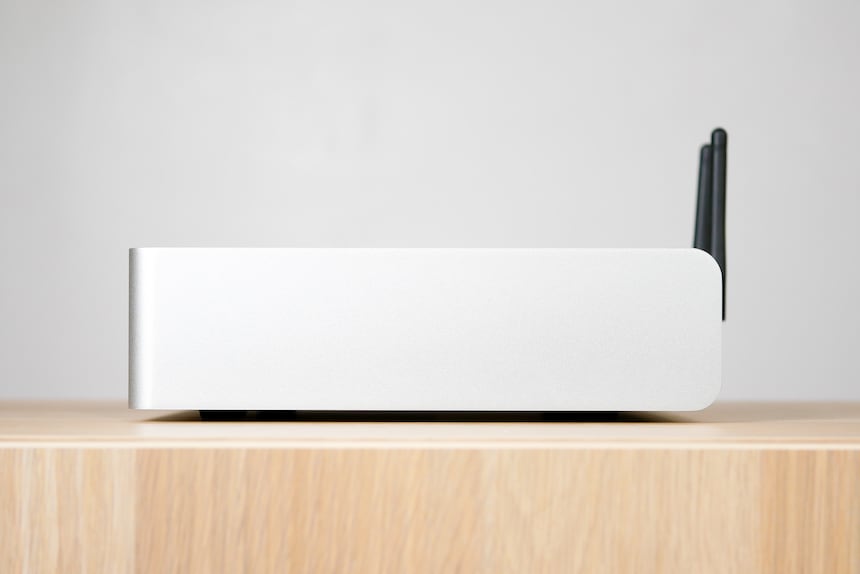
On the front, a large black panel conceals the central OLED screen, which displays text and icons in a distinctive yellow colour. The screen is large enough to display source names and logos clearly, and it visibly displays volume adjustments when changed. Despite this, it’s noted that it would perhaps be more convenient from a user’s view if the volume levels remained visible at all times, at the side of the screen.
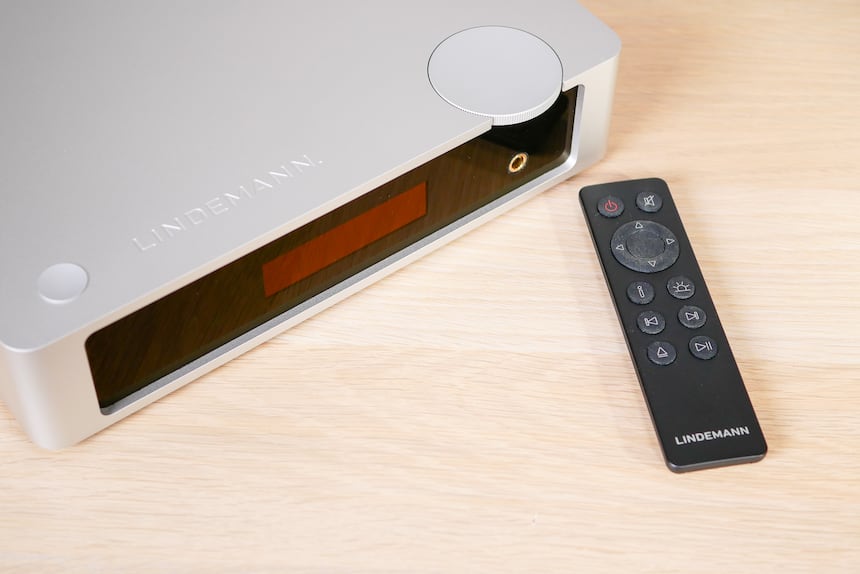
The device allows you to use a remote control to scroll through most menu items and information – with the exception, of course, of the track currently playing or its artist. Overall, the device’s controls are minimal, with a power button on the left and a horizontal volume knob on the right. While this might seem somewhat counterintuitive, getting used to the volume knob turning in the opposite direction is just a matter of habit.
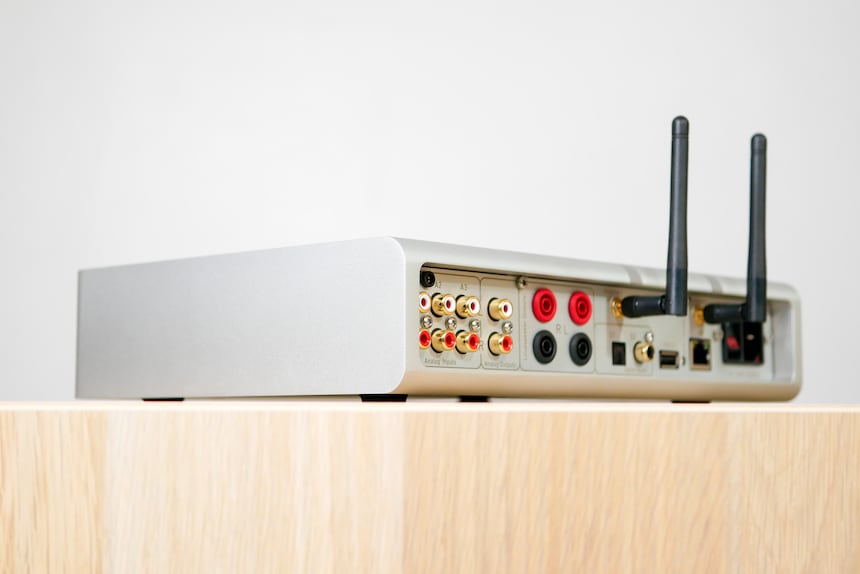
As an all-in-one device, the Musicbook Combo offers no less than six input ports for various sources. There are three analog input ports specifically for RCA connectors, one of which accommodates a turntable’s MM phono output. The digital section includes one Coxial Port for a Female RCA input, one optical audio port, and a USB port for playing files from a USB drive.
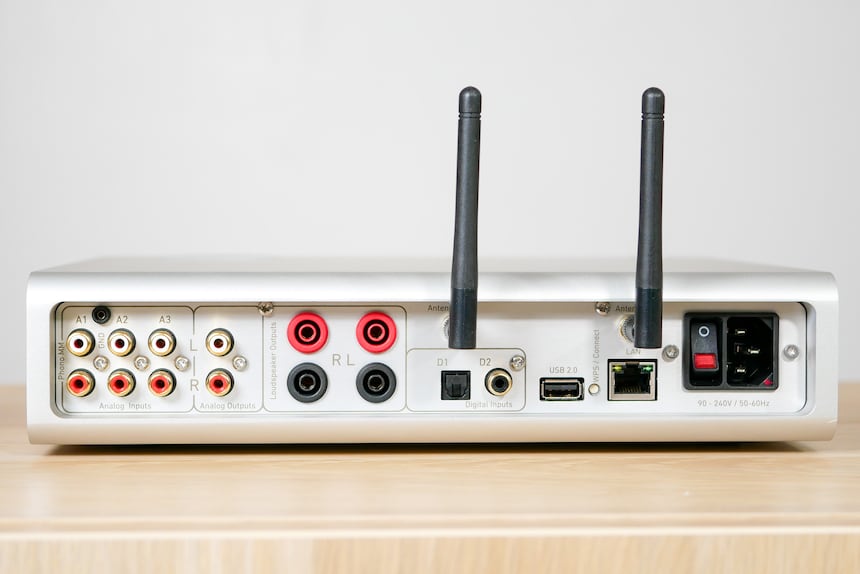
The output port on the back of the machine can be used to connect a subwoofer, while the front output allows for headphone connectivity. Speaker connections are made using 4mm banana plugs, and the Combo’s professional-style speaker terminals help optimise space by appearing on the rear panel. Two screw-on antennas are included for both WiFi and Bluetooth connections. Alternatively, you can always use a wired Ethernet connection.
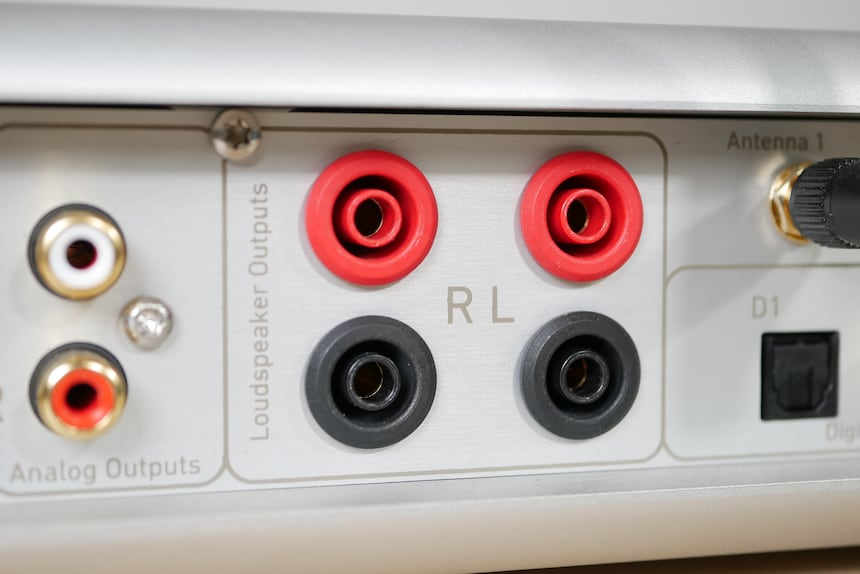
The Musicbook Combo has a power output of 2x70 Watts at 8 ohms and 2x130 Watts at 4 ohms, thanks to Class D amplification circuits. Notably, the damping factor sits at more than 500. The headphone output easily accommodates a wide range of headphones with impedance between 16 and 200 ohms and offers a gain adjustment of +12 dB. From a technical perspective, the Combo’s DAC transparently converts incoming digital streams to DSD before converting them to analog, enhancing the final audio quality.
Using the Musicbook Combo
While the front display provides basic control, full control of the device requires a dedicated app. Compatible with Roon, it can be controlled via the app to access both Qobuz and your music library. The Combo also includes a basic infrared remote control - although this is made of plastic and resembles remotes from other devices. A metal remote, matching the Combo’s design, would have perhaps made for a more elegant choice.

All things considered, Lindemann is one of the few HiFi manufacturers to develop its own mobile app. The app allows for easy access to the device’s settings (although the options are limited). You can’t make sound adjustments - but you can select the DAC settings to choose whether the DSD is output as-is or converted to PCM. The headphone output level adjustment is also available here. Other settings mostly relate to the user interface and to connectivity functions.
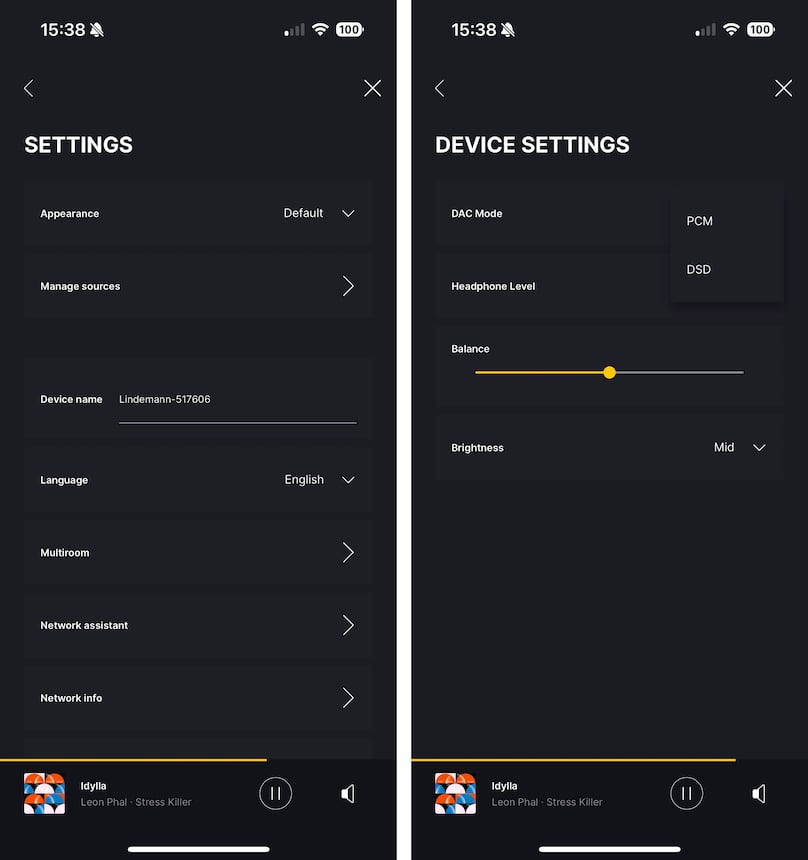
You can select which sources appear on the horizontal selection bar at the top of the app’s screen. This allows for access to WiFi or wired network settings, as well as for renaming the device, and checking for software updates.
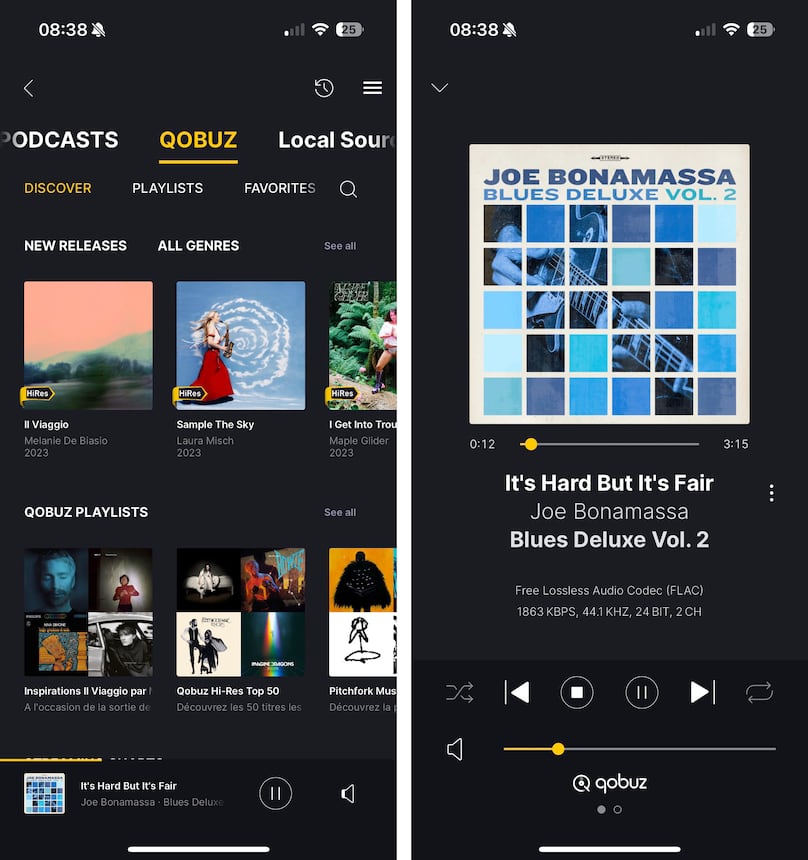
Lindemann has integrated Qobuz directly into its mobile app, which is useful since the device lacks AirPlay or Chromecast. The integration includes a “Discovery” section with new releases, Qobuz playlists, and more. It also features your personal playlists, favourites, and purchases – all accessible without the need for sub-menus.
The display screen shows the song format and quality in terms of bit rate and resolution. All information is clearly visible, and more detailed information is accessible by tapping three dots on the right. Lindemann is one of the few manufacturers that allows the customer to add tracks to an existing personal Qobuz playlist or create a new one directly from its app. Artist and album details are also accessible here.
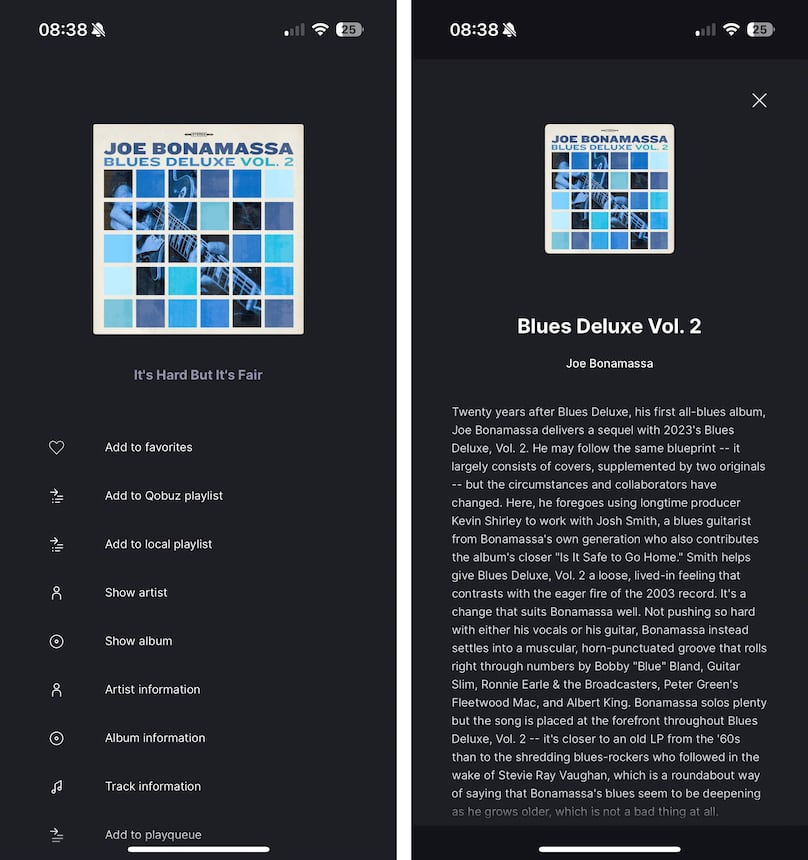
Listening Experience
Thanks to its integrated features, we made the simple decision to replace our usual testing setup with the Combo and connected it to our Dynaudio speakers. We used both the Lindemann app and the Roon app to test how it handled the streams.
We began with the jazz-funk sounds of Cassiopea to explore the Combo’s musical capabilities. Right from the start – we knew we wouldn’t be let down. The Combo delivered a powerful rhythmic presence, coupled with a great deal of melodic finesse. The drums and bass had a rounded and punchy quality, while the richness of the piano and guitar tones in the treble still managed to shine through. The instruments harmonized effortlessly without stepping on each other’s toes, even though they were all quite close to each other in the mix.
Listening to Joe Bonamassa’s latest album, Blues Deluxe Vol. 2 made it seem as though he was playing in the room with us. Every minute detail of the venue was faithfully reproduced, creating a wide soundstage that enveloped the whole room. Joe’s characteristic voice and the subtle intricacies of his electric guitar playing (especially in the upper-midrange) were both present without ever becoming ear-piercing. Some might describe the Combo’s output as a “big sound,” blending power and naturalness.

We found the Combo produced a profound sonic atmosphere that allowed us to fully appreciate the placement of the instruments in the Danish National Chamber Orchestra’s performance of Haydn’s Symphony No. 98. It was easy to distinguish the various sections, and they maintained their positions without overwhelming each other - even during dynamic crescendos. The listening experience required no extra effort; it allowed us to simply marvel at the virtual stage created by the Musicbook Combo.
With all these evident strengths in reproducing both complex and straightforward recordings, the Combo continued to impress when we made more modern selections. We enjoyed the benefits of all the sonic power available, as the Combo easily reproduced utterly unrestrained low frequencies – all while maintaining control. This was exemplified in the latest EP by Polo & Pan, where the deep and punchy rhythm seamlessly flowed through our speakers. The effect of presence also enhanced the resonances and reverberations that traversed the space, filling our listening space even more effectively.
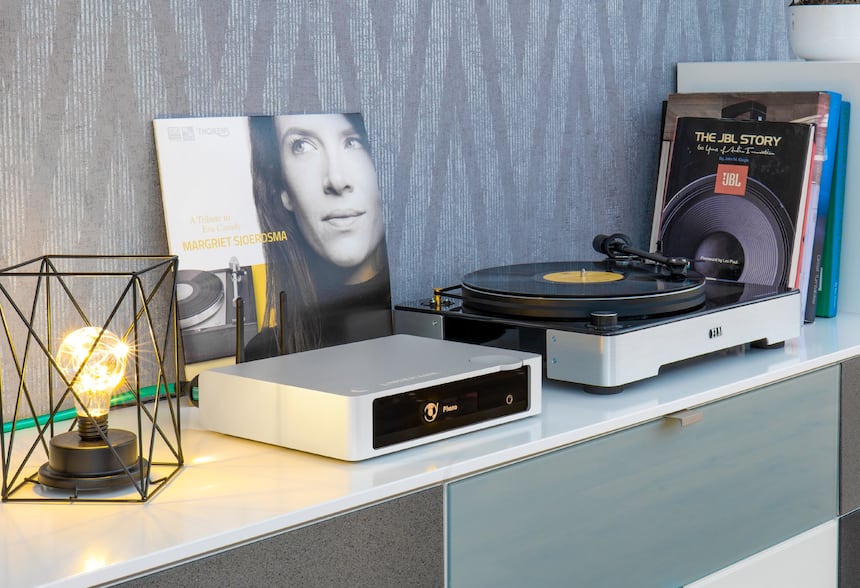
Conclusion
In the category of all-in-one integrated amplifiers, the Musicbook Combo stands out due to its musical qualities. Lindemann emphasizes that the DSD conversion process brings the listening experience closer to a purely analogue sound. While we won’t go that far, the Combo certainly offers mastery and a level of presence in its sound reproduction that you won’t find in many others. It delivers a kind of texture that contributes to a sense of authenticity – and that’s hard to do. The integration of Qobuz is a significant asset, although the overall connectivity could be more extensive. The Combo is primarily designed to replace a stack of high-end electronics, simplify your stereo setup and enhance your speakers - without sacrificing anything.